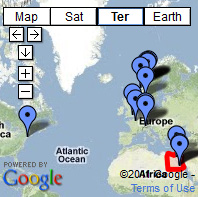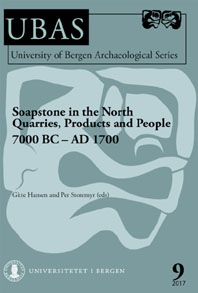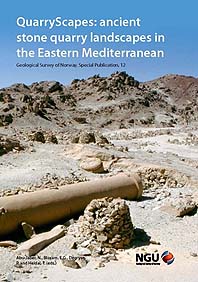Search this site
Welcome!
I work with the geoarchaeology of old stone: quarries, monuments, rock art. And I try to figure out about their weathering, and conservation using traditional crafts. I also burn lime the traditional way. My domestic services are managed through FABRICA, a registered Norwegian company established with good partners. On this website I publish articles on many aspects of cultural heritage. For the joy of old stone! Per Storemyr
Visit FABRICA’s website!

-
-
Recent posts
- Tradisjonell kalkbrenning i små, vedfyrte ovner. Erfaringer fra 6 brenninger i Tvedestrand
- Vinterbrenning av Brevikkalk. Med beskrivelse av kalkens geologi og egenskaper
- Middelalderkirker i stein: Hva mikroskopanalyse av kalkmørtler kan fortelle om historie, skader og mørtelvalg for restaurering
- Norwegian medieval lime mortars under the microscope
- Småskala kalkbrenning. Geologisk mangfold i kulturminnevernets tjeneste
Popular right now
Find posts by Google Maps

Follow on:

Follow on Facebook
SOAPSTONE! New book on its archaeology and history!

Book: The Stones of Nidaros Cathedral

Book: QuarryScapes

Get informed! State of the Art on natural stone today:

Tag Archives: lime mortar
Norwegian medieval lime mortars under the microscope
Happy New Year to all my readers! Having burnt lime the small-scale, traditional way for some time, over the last couple of years my interest in the fascinating world of old Norwegian lime mortars has intensified. As 2023 draws to … Continue reading
Fastings Minde i Bergen: Planlagt vedlikehold med vestlandsk tradisjonskalk etter en hard vinter
Sommeren 2020 ble grunnmuren på Fastings Minde fra sent 1700-tall reparert etter alle kunstens regler med tradisjonskalk. Arbeidet ble i fjor utført som et kurs i tradisjonsmuring i regi av byggherren, Universitet i Bergen, og i et samarbeid med mange gode krefter. Grunnmuren er svært værutsatt og burde ha blitt tildekket den første vinteren, for å sikre god herding av fuger, puss, slemming og hvitting. Vi lot det likevel stå til, fjernet stillas og tildekking. Og heldigvis: Muren har klart seg bra, med minimale frostskader, og det etter en temmelig hard bergensvinter. De små skadene som har oppstått ble i dag reparert i et samarbeid mellom Berit Bruvik og undertegnede – som del av et planlagt vedlikehold. Vi visste at det ville bli noen skader uten tildekking. Men vi visste også at tradisjonskalk er vedlikeholdsvennlig! Her er rapport om skadene og vedlikeholdet. Continue reading
Posted in lime burning, Marble, Monument conservation, Norway, Weathering history
Tagged Bergen, Fastings Minde, Hyllestadkalk, hyllestadmarmor, kalk, kalkbrenning, kalkhvitting, kalkmørtel, kalkslemming, kurs, lime, lime burning, lime mortar, Osterøykalk, restaurering, sand, tradisjonskalk
Leave a comment
Mangfold: Trippel tradisjonskalk til kalkarbeider i et gammelt trehus i Bergen
Bruk av tradisjonskalk blir ofte forbundet med kalking av middelalderkirker. Men om en vet hvordan tradisjonskalk skal brukes, så er det et sentralt materiale for utbedring av murvegger, piper, ildsteder og mye annet i alle slags eldre bygninger. Murverk i slike bygninger ble jo oppført med kalk i gamle dager! Her er et gjestebidrag fra Berit Bruvik om bruk av ikke mindre enn tre ulike tradisjonskalker for utbedring av brannmur og skorstein i den gamle trehusbebyggelsen i Bergen. Kalkene kommer fra Hyllestad, Bømlo og Nordmøre, alle nylig brent i kalkovnene i Kvernsteinsparken i Hyllestad. Stort mangfold. Slik det faktisk var i Bergen, ja over alt, for ikke veldig lenge siden. Continue reading
Posted in lime burning, Monument conservation, Norway
Tagged Bergen, conservation, Hyllestad, kalk, kalkbrenning, kalkovn, lime, lime burning, lime mortar, limekiln, restaurering, tradisjonshåndverk, traditional craft
Leave a comment
Partner in the Borgund Kaupang Project – on the rise and fall of a medieval town
My company is proud partner in the Borgund Kaupang Project (2019-2023), on the rise and fall of a “lost” medieval town. The project is coordinated by the University of Bergen and financed by the Norwegian Research Council. Together with Alf Tore Hommedal, my task is to source building materials such as marble, soapstone and lime for mortar and to interpret the whole building process, from quarries to churches. Thanks a lot to project manager Gitte Hansen, Therese Nesset and a great international team for a fine kick-off meeting in Ålesund last week! Continue reading
Posted in Marble, New projects, Norway, Old quarries
Tagged Borgund Kaupang, Borgundkaupangen, life in the middle ages, lime, lime mortar, marble, Middle Ages, soapstone
Leave a comment
Selja kloster: Hvor kom middelalderens kalkmørtel fra?
Det har en stund vært kjent at hvit og fin marmor ble brent for å lage kalkmørtel til byggingen av Selja kloster i middelalderen. Men hvor ble det brent? Hvor kommer marmoren fra? Her ute i havgapet, langt vest i Norge, er det ingen marmorforekomster. Man må til Sunnmøre eller Bergenstraktene for å finne marmor. Til marmor på Sunnmøre er det ikke langt, bare 20 km i luftlinje. Men i veien står Norges farligste hav, Stadhavet. I middelalderen ble bygningsmaterialer fraktet med båt! Turte man å gå 50-60 km på dette farlige havet, attpåtil med ytterst farlig brentkalk i lasten? Fraktet man heller ubrent kalk? Eller tok man heller den lange turen sørfra, mer enn 250 km? Vi har ennå ikke svaret, men med undersøkelser innen Riksantikvarens bevaringsprogram for ruiner begynner vi å nærme oss. Continue reading
Posted in Archaeology, Marble, New projects, New publications, Norway, Old quarries
Tagged georkeologi, kalkbrenning, kalkovn, lime burning, lime mortar, limekiln, marble, Middle Ages, Selja, Sunnmøre
1 Comment
Novel micro-images of lime mortar destruction by frost weathering
Frost is here again and thus weak building materials are at risk, for example traditional lime mortars applied during the last summer season. Over the last few days I was able to observe frost heaving in a lime mortar that has not properly hardened/carbonised due to recent rainy and moist weather. As far as I know, no one has previously documented such ice crystal growth, on a micro-scale. The phenomenon is akin to frost heaving in a soil profile: The force of growing ice whiskers lifting the uppermost parts of the soil. Continue reading
Taken by the frost! The beauty and destructive force of ice growth on masonry
After 29 years of working with weathering of cultural heritage, I have finally seen it “live”: How the force of ice can destroy plaster on stonework. It is more diverse than I though. A complex and fascinating world of beautiful … Continue reading
Posted in Heritage destruction, Monument conservation, Norway
Tagged frost heaving, frost weathering, Hyllestad, lime mortar, limekiln, Norway, salt weathering, weathering
3 Comments
Frostforvitring på kulturminner: Bilder av et fenomen få har dokumentert og formidlet
Mange har meninger om frostforvitring på kulturminner, på stein, murverk, puss og mørtel. Men det er få som har dokumentert fenomenet med bilder. Derfor er det mye synsing om «isens ødeleggende kraft». Her presenteres nye fotos av hva som faktisk kan skje når kalkmørtel blir offer for frost. Det dreier seg bl.a. om islinser som dannes og vokser i eksisterende svakhetsplan og sprenger biter bort. Stedet er den nye, «middelalderske» kalkovnen i Kvernsteinsparken i Hyllestad i Ytre Sogn. Continue reading
Posted in Monument conservation, Norway, Ruins, Weathering history
Tagged frost weathering, Hyllestad, Kvernsteinsparken, lime mortar, limekiln, weathering
Leave a comment
Burning the beaches. Happy New Year from the Faroe Islands!
The Faroe Islands, in the middle of the North Atlantic Ocean. Basalt and other volcanic stone everywhere! Yet, many buildings on the islands were erected by the use of lime mortar, from the Middle Ages on. There is absolutely no limestone on the Faroes. Thus, lime mortar had to be produced by “burning the beaches” – collecting shells from beach deposits, stacking the shells above a fire in a field kiln – and let it happen: Hold the temperature at some 900 degrees centigrade for a couple of days, and out comes quicklime to be mixed with water and beach sand for the mortar. Continue reading
Posted in Archaeology, New projects, Old quarries
Tagged Faroe islands, lime burning, lime mortar, limekiln
5 Comments
HOTMIX! Nybrent Hyllestadkalk leskes og testes som restaureringsmørtel på Stavanger domkirke
Endelig i gang med hotmix! Med lesking og testing av nybrent Hyllestadkalk til bruk i mørtel for restaurering. Som mange vil huske, brant Norsk Kvernsteinsenter lokal marmor i en nybygd «middelalderovn» i Hyllestad sist juni, et prosjekt støttet av Riksantikvaren. Planen er å leske og teste brentkalken på flere restaureringsprosjekter i Norge, bl.a. på Selja klosterruiner og Stavanger domkirke. Sidene jeg regelmessig jobber sammen med kollegaer i Stavanger, har vi nå gjort flere tester på domkirken med George Murphy og Bjørn Idland, som er restaureringsmurere ved Arkeologisk Museum (UiS). Det er ikke lett å leske kalk som er brent på tradisjonell måte. For det vil alltid være halvbrente og ubrente biter i slik kalk. Akkurat som i middelalderen. Vi lesket kalken på tre ulike måter, og det var liten tvil: tradisjonell hotmix ga det foreløpig beste resultatet! Continue reading
Posted in Monument conservation, New projects, Norway
Tagged experimental archaeology, lime burning, lime mortar, limekiln, marble
1 Comment

